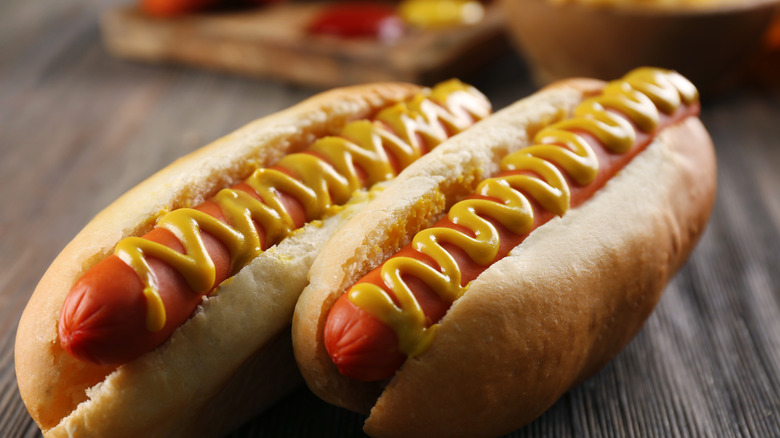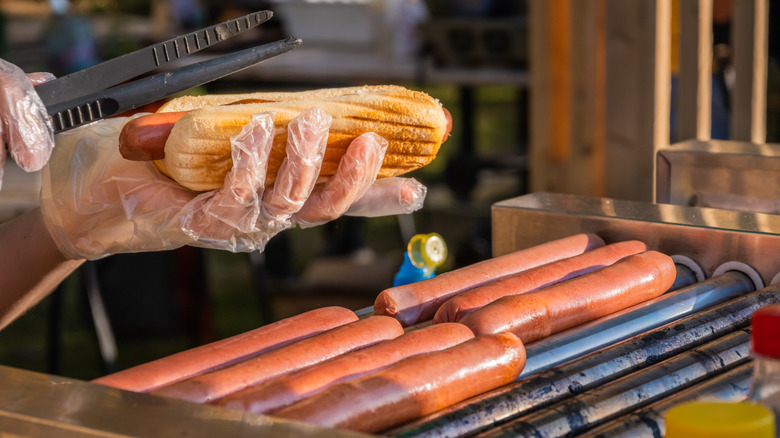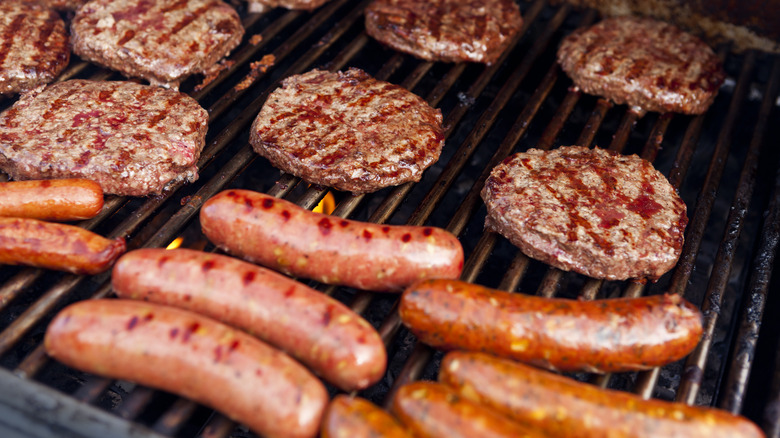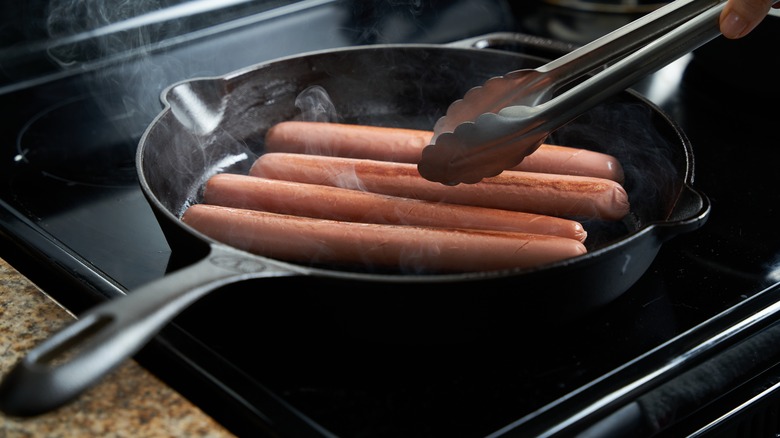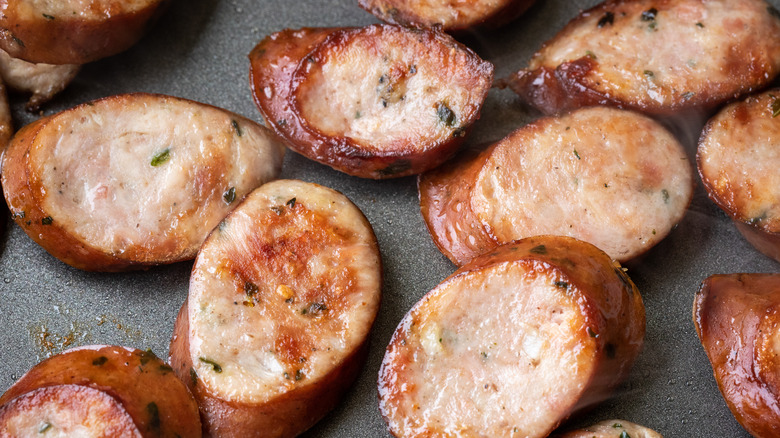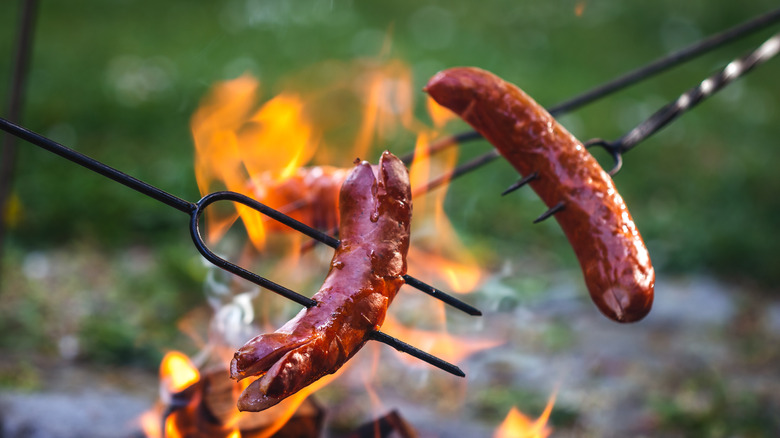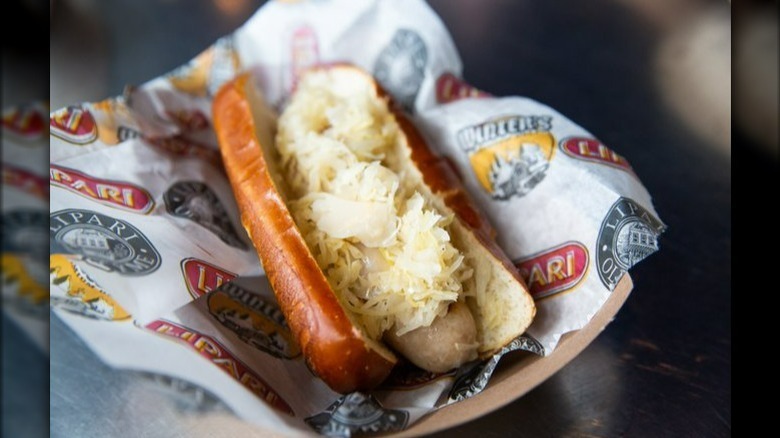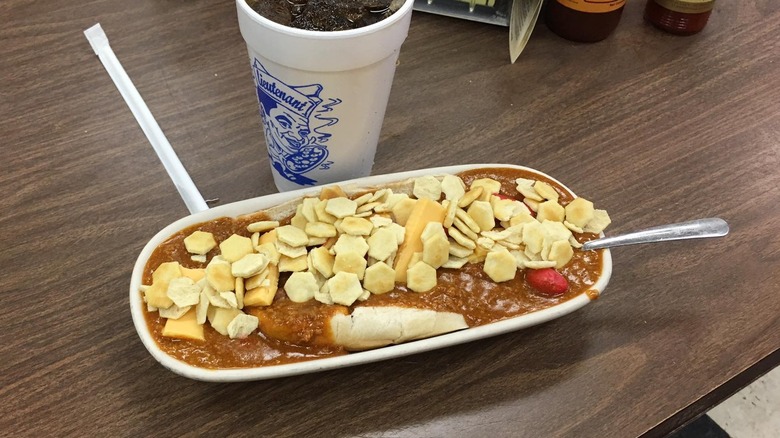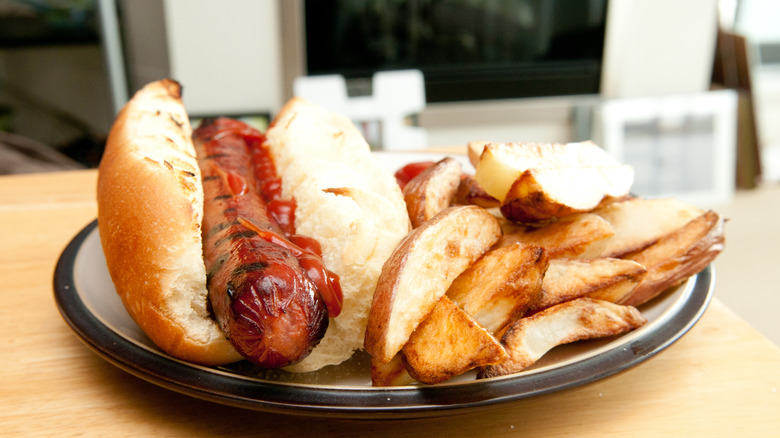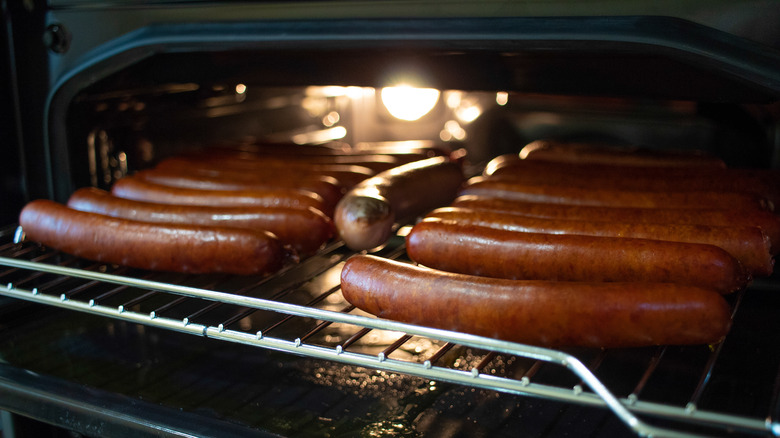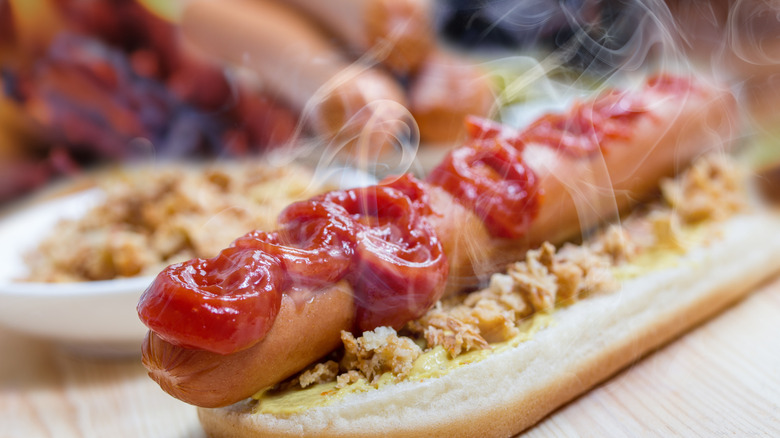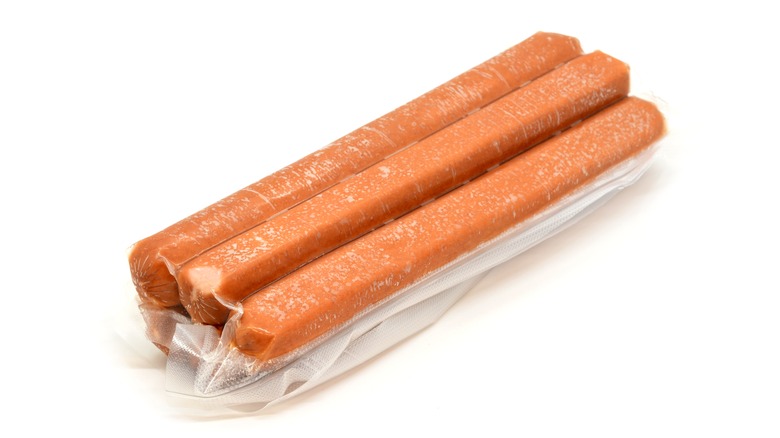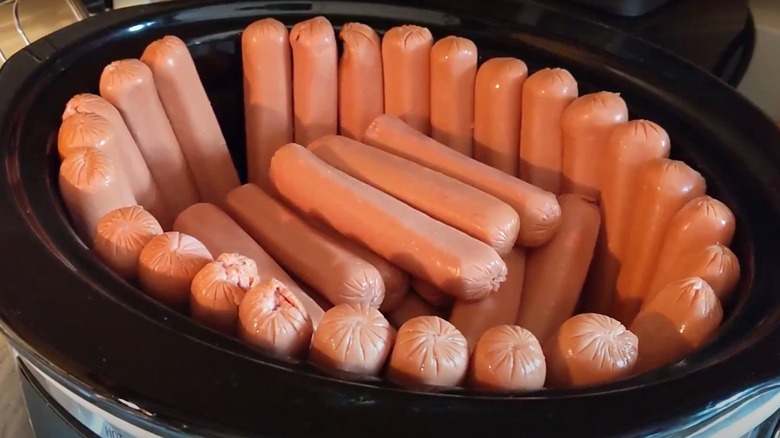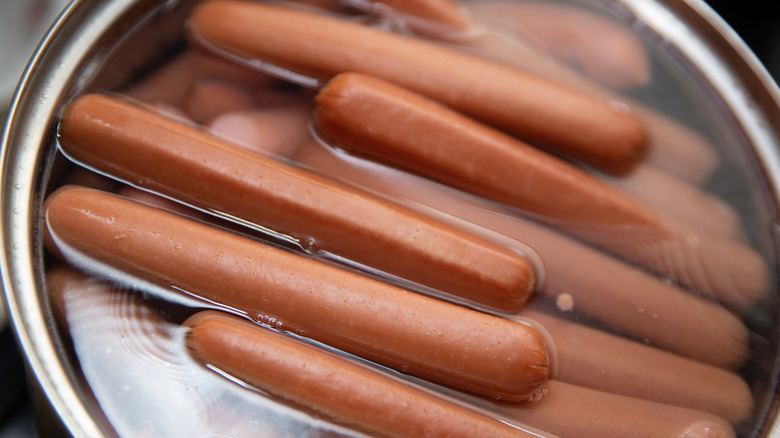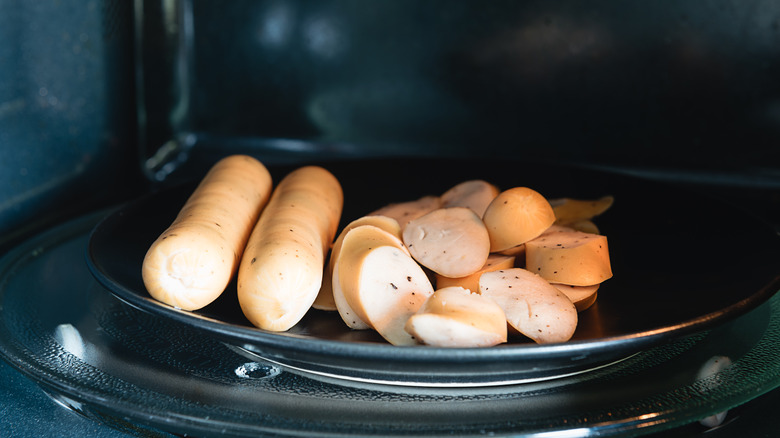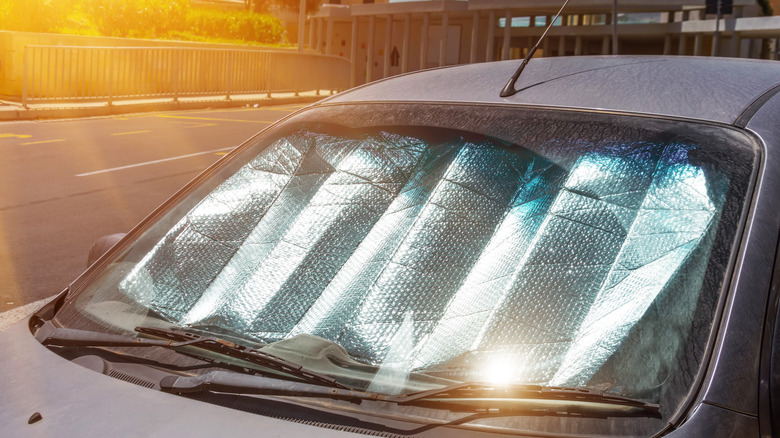15 Best And Worst Ways To Cook A Hot Dog
The humble yet beloved hot dog is a staple of baseball games and warm summer days outdoors with friends. It's simple. It's salty. It's versatile enough to be the star of the meal encased in a bun, or a supporting character served as a chili dog. Whether you need an easy way to feed party guests or a quick lunch to scarf down before getting back to work, a hot dog has your back.
As simple as it is, many people assume you can't really mess up the preparation. After all, it's already pre-cooked before it gets packaged and sold, so all you're really doing is heating it up, right? Wrong. Well, technically that's not wrong. But there's a world of difference between heating a hot dog on a grill where it can develop a crispy skin and layers of smoky flavor and heating it up in a pot of boiling water where it will be drained of its flavor. Here are the absolute best and worst ways to cook a hot dog.
1. Best: Use a rotisserie
If you have an air fryer or other small convection oven with a rotisserie attachment, do yourself a favor and try cooking hot dogs in it. If you don't have one of those appliances, you can also get a rotisserie kit for your oven.
The advantage of a rotisserie over just tossing your hot dogs in an oven is the constant rotation. The movement ensures that the juices seeping out as the meat cooks are soaked right back in rather than dripping off (via Dizzy Lamb). In addition to a juicier hot dog, the meat is continuously basted in its own grease which helps create crispier skin across the entire dog.
Another perk is that the meat cooks evenly. When a hot dog is resting on a pan or grill, one side is exposed to more heat than the other. On a rotisserie, the meat is heated on all sides throughout the entire cooking process. Plus, you get all those benefits without having to constantly flip your dogs as you do on a grill. A rotisserie is a low-effort method that yields perfect results — so it's no wonder it's the most common method you find at hot dog stands around New York City.
2. Best: Throw it on a grill
Grilled hot dogs are a close second to those cooked to perfection on a rotisserie. But the catch is you have to do it right — and doing so takes a lot more active effort on your part. Instead of a rotisserie that constantly turns the franks for you, grilling means you'll have to stand there and frequently flip each dog. You also need to make sure that they aren't too close to the grill flames until you're ready to finish them off with a light char.
If you skip this step, you can end up with a rubbery interior cased in skin that's charred beyond recognition. But if you nail it, you end up with a deliciously crisp, juicy hot dog with a hint of smokiness from the grill that really takes the dish to the next level. This is an especially good method to use if you plan to top the hot dogs with tangy or spicy condiments like mustard, sauerkraut, or hot peppers. The depth of smoky flavor in the meat balances well with the bright tang and sharpness of these toppings.
3. Best: Panfry it
Bringing out a rotisserie or grill when you're just cooking a quick lunch for one might seem like overkill. In that case, the best quick-and-easy way to cook a hot dog is in a pan. With the right technique, you can get crispy, seared skin wrapped around a tender, flavorful interior.
While a pan should reliably yield tasty results, skipping a step or getting impatient can lead to an undercooked or burnt hot dog — both mediocre outcomes. So don't be tempted to rush through the process. It may just be a hot dog, but give it the care and attention of haute cuisine to get the best possible meal.
To start, thoroughly preheat your pan over medium-high heat. You want the hot dog to sizzle the moment it touches the pan. Otherwise, the skin will end up soggy and blistered instead of crisp and salty. As it sizzles, rotate it every one to two minutes until it is plump and seared on all sides. If you're feeling decadent, toss a lump of bacon fat, duck fat, or butter in the pan before frying for extra richness and flavor. And if you're feeling whimsical, slice the hot dog into an octopus shape before frying.
4. Best: Stir-fry it
In the United States, hot dogs are generally eaten whole and tucked into a fluffy bun. It's a classic for a reason but there are other ways to serve a sausage that are just as delicious. When you're ready to switch up your hot dog game, one of the best alternatives is to chop and stir-fry it.
In the Philippines, stir-fry hot dog is served as sizzling hot slices, topped with a ketchup-based sauce and onions. The dish is washed down with a crisp, cold beer. The hot dog slices are really just a vessel for the sweet, tangy, spicy sauce but it really hits the spot when you're craving something savory late at night.
A similar stir-fried hot dog dish is popular as a street food in Peru. Salchipapa consists of a sliced sausage that is stir-fried in a bit of oil and served on a bed of crispy french fries with a drizzle of chili sauce and crema. Both options make for a decadent but easy-to-cook meal that gives new life to a hot dog when you're tired of serving it in a bun with ketchup and mustard.
5. Best: Roast it over a campfire
Hot dogs roasted over a campfire are a classic, but successfully pulling off this preparation can be tricky. The direct flames can end up charring the outside long before the inside has time to really cook through. Instead of a plump and juicy texture that makes a hot dog so delicious, the inside will be rubbery and cold.
To avoid subpar results, the first step is to let the fire get low before you start. This will give you plenty of glowing embers and only a few flickers of flame. Then, place the dogs in a grill basket with a long handle or on a two-pronged skewer. Once your hot dog is secure, hold it above the fire pit and rotate it often. You want to recreate a rotisserie effect here, ensuring that all sides are evenly exposed to the heat without being exposed long enough to develop a char before the inside is cooked.
When the hot dog looks swollen and the skin looks like it's ready to peel or has begun to burst, dunk it right into the flames for a few seconds to get a light char on all sides. Then, slide it off the skewer into a bun and top it with your favorite condiments.
6. Best: Braise it
Braising is a two-step cooking method that can make you feel like a Michelin-star chef but is actually fairly easy to master. When used to make hot dogs, it's pretty hard to mess up and yields an incredibly juicy result without losing any flavor.
To pull it off, start by simmering some beer and sugar in a pan over medium heat. Once you have a gentle but consistent simmer going, add your sausages and let them simmer in the beer mixture for about 10 minutes. Meanwhile, use a cooking utensil to regularly shift the hot dog so that all sides have a chance to be submerged.
As the franks simmer in the beer, they reabsorb their own juices and soak in the flavors while developing an almost caramelized skin and a tender, meaty inside. For the perfect finish, transfer the sausages to a dry preheated pan to sear each side for a few seconds. This will really seal in the flavors and finish caramelizing the skin. Traditional braising methods with raw cuts of meat usually call for searing first and simmering after. But with hot dogs, you're not simmering them for hours, so braise them first in order to give the juices a chance to penetrate into the meat.
7. Best: Scramble it
Another regional hot dog style is the scrambled dog, found mainly in Georgia. This version is comfort food at its most comforting. The sausage is chopped and fried in a skillet with onions then served on top of a grilled, open-face hot dog bun with chili, cheese, coleslaw, pickles, and oyster crackers.
The final dish is an explosion of flavor, featuring sweet, savory, and tangy elements. The textural profile is equally exciting, thanks to the lively combination of crisp pickles and coleslaw, tender chili and hot dog bites, and crunchy oyster crackers.
It's also pretty easy to make, provided you opt for canned chili instead of making your own. Just heat up the chili in a pot while you grill the hot dog bun in a pan until it forms a light, toasty crust. Then, fry up the hot dog and onions in the same pan. From there, it's just a matter of assembling your ingredients in a generous heap on top of the bun.
8. Best: Put it in an air fryer
While a hot dog cooked in an air fryer won't compare to a grilled hot dog — unless your appliance has a rotisserie option — it's a worthy contender for the sheer fact that it's quick, easy, and preserves flavor and texture better than boiling or microwaving.
No preheating is required and it only takes four to six minutes to cook a hot dog on the air fry or air crisp setting. Not to mention, zero flipping, basting, or rotating is required; just set the timer and let it cook. And the only cleanup afterward is to rinse off the basket and put it in the dishwasher. This low-effort method produces a result similar to a grilled hot dog, with crispy skin but no smokiness.
For anyone who resorts to microwaving simply because they don't want to deal with prep work or clean up, an air fryer will meet your needs and deliver a much more enjoyable meal. Plus, you can air fry the bun for a couple of minutes too and serve yourself a gourmet hot dog in under 10 minutes.
9. Worst: Bake it in an oven
In theory, an oven will do the same thing to your hot dog as an air fryer does. After all, an air fryer is essentially a small convection oven. In practice, it's not quite the same though. The most notable difference is that an oven needs to preheat. If you skip this step or don't wait long enough for it to fully preheat, you risk either undercooking your hot dog or cooking it so long that it dries out. Instead of a plump and juicy frank, you'll have a spongy dry one.
You don't have much room for error here either. An extra minute or two past the point of perfect doneness and your hot dog could shrivel into a tough wrinkly log. You'll need to constantly watch the sausages cooking in the oven until you learn exactly how long it takes your appliance to produce the perfect result.
If an oven is your only option, use the broiler function instead. It only takes about five minutes to preheat, compared to the 15 to 20 minutes it takes for most ovens to preheat to 400 degrees Fahrenheit. Then, it will cook the meat in only four to six minutes. Just remember to flip the sausages about halfway through so both sides are exposed to the heating elements.
10. Worst: Steam It
Some folks swear by steamed dogs. It's a relatively simple cooking method and there's a lot of wiggle room for error. If you leave a hot dog in a steamer basket a little longer than needed, it's not going to dry out as it would in an oven or on a grill. Some people also claim it's healthier since you're not using extra oil or butter as you might in a pan, air fryer, or oven. But as the saying goes, no matter how you dress a pig, it's still a pig. No matter how you cook your hot dog, it's still a hot dog. If you want a healthier lunch, serve it with a side salad.
Steaming isn't our recommended approach to cooking a hot dog because you can't crisp up the skin. The interior texture might be fine but without the snap of the crispy exterior with every bite, it's really just a mushy tube of meat. If you really must steam your hot dogs, you should at least sear them in a preheated pan for a few seconds on each side before serving to improve the texture.
11. Worst: Sous-vide it
Sous vide is a technique in which you place food in a vacuum-sealed bag and then submerge it in a hot water bath, keeping the water at a consistent temperature for the duration of the cook. Once an obscure experimental method, The New York Times reports that it has grown in popularity over the last decade or two as sous-vide equipment becomes more and more affordable.
The key advantage is that you get a consistent temperature for the entire cook time and there's little risk of overcooking. Once the food's internal temperature reaches the temperature of the surrounding water, it just stays at that temperature. That means you can accidentally leave something submerged long past the time it was done without ruining the dish.
While that's great for a lot of foods, a sous-vide hot dog ultimately suffers from the same problem as a steamed hot dog: no crispy skin. While you can sear the hot dog in a pan after you sous-vide it, you're really just adding extra steps for no reason. Pan frying gives you both a sear and juiciness in about 10 minutes. A dual sous-vide and sear method would take 30 minutes to an hour in the water and then another five minutes in the pan.
12. Worst: Put it in a slow cooker
The slow cooker method might do in a pinch but just like the steamer or sous vide, you won't get that contrast of crisp skin and a plush flavor-packed interior. Plus, it's a slow cooker. It might be convenient if you want a hot dog four hours from now, but if you're trying to make a quick lunch, it's not the best way.
With that said, there is one case for slow-cooking a batch of hot dogs. If you're hosting a backyard barbecue or party, you can use the slow cooker to pre-cook the dogs before grilling. Dump the whole batch into your pot, close the lid, and cook on low for four hours or so before your guests start arriving. This will plump up the inside so that when it's time to put the sausages on the grill, all you're really doing is searing the outsides for a few seconds before they're ready to serve.
In that scenario, you can feed a large group without spending as much time actively cooking. Instead of being tied to the grill all afternoon, you can quickly sear each dog and get back to hanging out with friends. Outside of feeding large groups, though, there's little reason to slow-cook a hot dog.
13. Worst: Boil it
A boiled hot dog is a bland hot dog, plain and simple. When you plunk it in a pot of boiling water, all the salt and flavor leach out into the water as it cooks. The inside might still be plump and juicy, but it will be filled with water instead of flavor. Boiling also doesn't crisp up the skin so you won't get that explosion of flavor and contrasting texture either.
Of course, you might want more of a muted hot dog for dishes where you don't want the frankfurter to steal the spotlight from another ingredient, like chili or sauerkraut. But boiling still just isn't the answer. Instead of dunking the sausages directly in boiling water, throw a steamer basket over the pot and steam them instead. You don't lose as much flavor this way and you'll still get a softer, neutral base so your other hot dog toppings can shine.
14. Worst: Heat it in a microwave
To be fair, when people opt for the microwave, it's usually more about convenience than getting the perfect cook. But still, there are many options that don't require too much effort and will give you a much better result. The main problem with microwaves is that they don't distribute heat evenly. There's little you can do about it because you're cooking with electromagnetic waves, not radiant heat.
As explained by Genuine Ideas, the waves in a microwave oven can penetrate beneath the surface of the food but don't spread throughout. So you end up with some spots that are zapped to a scorching heat and others that are ice cold. To make matters worse, the high salt content makes hot dogs highly conductive. Instead of penetrating into the center, all that electricity is absorbed by the salty surface. So you've got a hot dog with scorching spots along the surface that isn't even cooked through.
According to a 2009 study in the Journal of Food Science, an uneven cook can also be unsafe. Undercooked hot dogs can harbor dangerous bacteria. The researchers found that to be safe, you should cook a hot dog at 1,100 watts for at least 75 seconds in a bowl of water. At that point, the hot dog should be safe — but it will also be spongy and soggy.
15. Worst: Sun bake it in your car
If you live in a climate where summers get so hot you feel like you're baking inside your car, you've no doubt wondered if you actually could actually bake something in it. Well, the answer to that question is yes, but you probably shouldn't.
In a 2018 experiment, researchers at the University of Texas at Dallas placed hot dogs, cookie dough, and other foods on the dashboards of cars parked in the sun. The internal temperature of the car reached up to 180 degrees Fahrenheit, enough to cook a hot dog to an internal temperature of 165 degrees Fahrenheit.
That's actually a safe internal temperature for ground meat, according to the U.S. Department of Agriculture, so you could technically cook and eat your hot dog with this method. But you might regret it when your car smells like hot dogs for days afterward.
